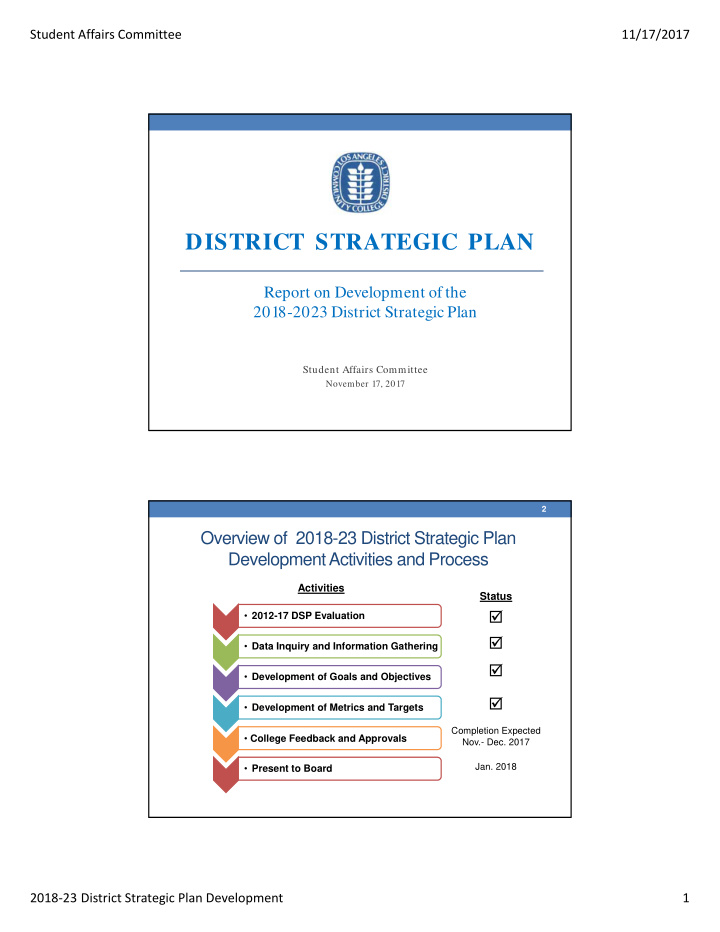



Student Affairs Committee 11/17/2017 DISTRICT STRATEGIC PLAN Report on Development of the 2018-2023 District Strategic Plan Student Affairs Committee November 17, 2017 2 Overview of 2018-23 District Strategic Plan Development Activities and Process Activities Status • 2012-17 DSP Evaluation • Data Inquiry and Information Gathering • Development of Goals and Objectives • Development of Metrics and Targets Completion Expected • College Feedback and Approvals Nov.- Dec. 2017 Jan. 2018 • Present to Board 2018 ‐ 23 District Strategic Plan Development 1
Student Affairs Committee 11/17/2017 3 Background on 2012-17 District Strategic Plan (DSP) • Followed the first DSP which covered the period 2006-11 • Resulted from a year long process involving: • Environmental scan • Analysis of strengths/weaknesses/opportunities/threats (SWOT) • Feedback from focus groups and external and internal constituencies • Coordination by EPIE, District Planning Committee, and District Strategic Planning Taskforce • Contained 4 goals and 13 objectives • Approved by Board in Feb. 2012 • Allowed for the development of districtwide priorities • Served as a planning framework for the colleges 4 Background on 2012-17 District Strategic Plan (DSP) • Critical in demonstrating district-level integrated planning (Standard IV.D.5) • District/system planning and evaluation are integrated with college planning and evaluation to improve student learning and achievement and institutional effectiveness • Basis for District Effectiveness Cycle (including annual effectiveness reporting, Board review, and goal setting) 2018 ‐ 23 District Strategic Plan Development 2
Student Affairs Committee 11/17/2017 5 2012-17 DSP Summary 6 2018-23 DSP: Guiding Principles for Plan Development • Incorporate input from Board, colleges, and external constituencies • Utilize evaluation of 2012-17 DSP • Include measures utilized in state and federal accountability systems • Set targets for each measure based on Board, state, and federal accountability targets • Identify high quality data sources for each measure • Do not prescribe strategies • Allows colleges to align with DSP according to their own priorities and planning cycles 2018 ‐ 23 District Strategic Plan Development 3
Student Affairs Committee 11/17/2017 7 2012-17 DSP: Evaluation • EPIE compiled data on plan metrics and College Effectiveness Reports over the period 2012-17 • EPIE and District Planning Committee developed a District Strategic Plan Comprehensive Evaluation Report • Vetted through the District Planning Committee and District Research Committee • Analyzed outcomes data on plan metrics • Analyzed validity of metrics • Obtained qualitative input from colleges on plan outcomes • Developed recommendations for 2012-18 DSP • Presented DSP Evaluation Report to Institutional Effectiveness and Student Success Committee 8 2018-23 DSP: Data Inquiry and Input Gathering Processes • Board’s Annual Planning Meeting (August 2016) provided focus areas and Board goals: • Student Completion (10% pt. increase) • Improve Customer Service • Full day planning retreat facilitated by Governance Institute for Student Success (GISS) at LAMC in Oct. 2016 • EPIE conducted DSP planning forums at each college and for education, workforce, and civic groups • Input was used by District Planning Committee to develop goals and objectives 2018 ‐ 23 District Strategic Plan Development 4
Student Affairs Committee 11/17/2017 9 2018-23 DSP: Mission and Vision Mission Statem ent The Mission of the Los Angeles Community College District is to foster student success for all individuals seeking advancement, by providing equitable and supportive learning environments at our nine colleges. The District empowers students to identify and complete their goals through educational and support programs that lead to completion of two or four-year degrees, certificates, transfer, or career preparation. In doing so, the District fulfills its commitment to the community to improve the social welfare of the region, to enhance the local economy, to close persistent equity gaps, and to prepare future community leaders. Vision Statem ent The LACCD will strive to become a national leader in student success by providing high quality, accessible, educational opportunities across the greater Los Angeles area that improve students’ lives, enrich the area’s many diverse cultures, and strengthen the regional economy. The District will do so by continuing to provide a culture of continuous learning and by closing persistent equity gaps. 10 2018-23 DSP: Goals, Objectives, Measures, & Targets Goal 1 : Access to Educational Opportunities We will the increase college going rate for the Los Angeles region through enhanced outreach to community and educational partners and expanded access to educational programs that meet community and student needs. Objective 1: We will expand educational opportunities to local high school students by increasing the number of courses offered through dual enrollment. A 25% increase in the number of sections offered through dual enrollment A 25% increase in the number of students who are dual enrolled Objective 2: We will fully implement the LA College Promise and will seek to expand the promise to additional school districts and municipalities in the service area. A 50% increase in the number of students enrolled in the LA College Promise Program 90% of LAUSD schools served by the LA College Promise Program Objective 3: We, in partnership with Los Angeles Regional Adult Education Consortium, will increase educational opportunities to nontraditional students through the expansion of noncredit adult education courses focused on skills improvement and vocational training. A 25% increase in the number of noncredit adult education sections A 25% increase in the number of students enrolled in noncredit adult education courses Objective 4: We will improve outreach strategies for new and returning students through effective marketing and branding that increases the recognition of LACCD colleges and programs as premier in the community. A 25% increase in the number of first ‐ time students A 25% increase in the number of returning students 25% of students endorsing very much or quite a bit when asked whether their decision to enroll was impacted by newspaper, radio, or television advertisements 25% of students endorsing very much or quite a bit when asked whether their decision to enroll was impacted by social media 2018 ‐ 23 District Strategic Plan Development 5
Recommend
More recommend